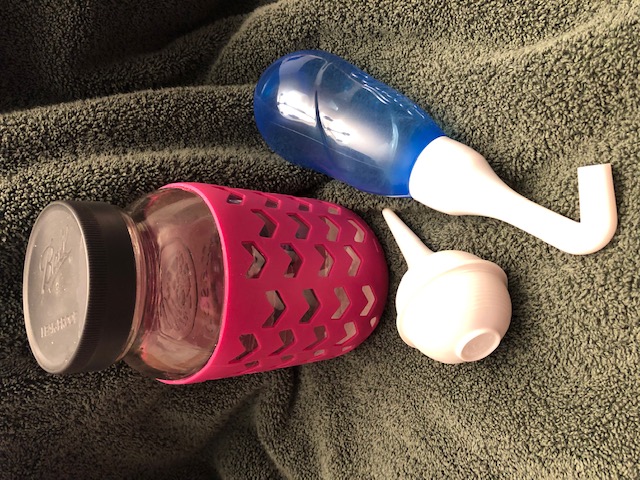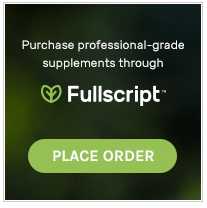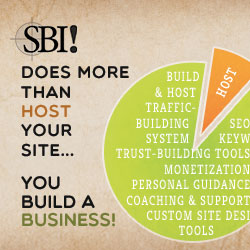Sinus Flushing
 |
Sinus flushing is a simple procedure that helps to keep your sinus microbiome balanced by flushing out contaminants that may cause dysbiosis. It is not difficult or time-consuming to do, and this page will help you learn how it may help you and how to do it. |
I detailed what the science shows about a healthy sinus microbiome, what drives chronic rhinosinusitis and dysbiosis, and which probiotics may be helpful to support healthy sinuses on this page. Not only did I research the topics, but I also have personal experience from many years ago with chronic sinus infections. I was able to eliminate stagnant, infected sinus junk with a change in diet, improvement in gut and sinus microbiomes, and adoption of a simple procedure that is the focus of this webpage.
We should never take our health for granted, however, because there are always assaults to it. Keeping our sinus microbiomes healthy and stable is always the best preventive defense against any nasal assault, so the probiotics and information in the sister webpage are definitely important and should be read first. This webpage builds on that information and offers additional sinus health support recommendations.
Why Do Sinus Flushing?
Contaminants in the air (viruses, bacteria, exhaust particulates, dust,
pollen, dander, molds, etc.) provide assaults with each breath we take.
Contaminants enter our respiratory system through the nose and mouth.
Since mouth breathing disrupts the oral microbiome, most people breathe
through their noses. After all, that’s what they are designed for!
Air
enters the nasal cavity and sinuses where it is warmed, and
contaminants are hopefully captured in the sticky mucus for
identification and elimination. Cilia, hair-like projections, move the
mucus out of the sinuses and into the back of the throat.
Sinus flushing, also known as nasal irrigation, offers the body support during the many times when it is advantageous to assist the body in clearing out the mucus, such as in chronic sinusitis, the subject of the sister webpage, or when a heavy load of contaminants, like COVID viral particles, is encountered. In fact, two 2020 studies stated that there were higher COVID viral loads in the nose than in the throat. Modeling suggests that aerosols containing the virus are concentrated in the nose, and from the nose, the virus seeds other parts of the body.
Sinus Flushing Reduces Contaminants
Sinus flushing or irrigation can be performed with positive pressure from bulb syringes, by negative pressure by sniffing solution, by inhalation from nebulizers, and by gravity-based pressure with a device such as a neti pot. Nasal irrigation is a simple and inexpensive procedure in which a solution is flushed through the nostrils into the nasal/sinus cavity, and it has been in use for hundreds of years.
A 2018 review on chronic rhinosinusitis showed that nasal irrigation generally has more benefits than placebo despite the variations in frequency and duration of treatment, the type of device used, and the type and amount of solution used.
The mechanisms of action many be many-fold:
- enhanced beating frequency of cilia (hair-like structures)
- softening of thick secretions so they can be expelled
- removal or viruses, bacteria, allergens or other irritants
- and/or removal of inflammatory mediators such as histamines, prostaglandins, leukotrienes, and defensins (antimicrobial peptides that may increase inflammation)
Hypo-, Iso-, and Hyper- Sinus Flushing
A brief summary of some terms is necessary to understand sinus flushing products. Osmotic pressure is a kind of hydrostatic pressure that determines whether a solution of water will pass into or out of a tissue. If we use a solution that has less osmotic pressure than our tissues, it is called hypotonic. If we a solution that equals our osmotic pressure, it is isotonic, and if we use one with a higher osmotic pressure, it is hypertonic. A hypotonic solution will be drawn in, an isotonic solution will stay neutral, and a hypertonic one will draw out fluid.
Sinus Flushing Solutions
There are many home-remedy and commercial preparations for sinus flushing solutions. Hypertonic (3%) nasal irrigation was more effective than isotonic nasal irrigation in improving mucociliary clearance in a study on acute bacterial sinusitis, and buffered solution with baking soda may provide additional benefits in decreasing mucous viscosity and increasing beating of the cilia. Some preparations may include antibiotic or antifungal agents.
Thankfully, I am not a manufacturer of sinus flushing products, so I can safely cite studies for your information without implying that any of these products can prevent, treat, or cure human disease. They are only for sinus health support. Why is that important? It is important because even though studies show the benefits of nasal irrigation for allergies, sinusitis, COVID viral load reduction, etc., manufacturers such as Neil Med, a popular saline brand, and Xlear, a xylitol-based nasal spray, were sent warning letters from the US FDA in 2020 claiming that it was unlawful for them to make unsubstantiated claims for coronavirus prevention or treatment.
In response, according to Xlear, US Congresswoman Nancy Mace (R-SC) sent a letter to US Health and Human Services Secretary Xavier Becerra in February 2022 asking why public health officials have neglected to include basic nasal hygiene in their COVID recommendations as a multi-layered approach, especially given the published research demonstrating the benefits of nasal products for COVID outcomes.
Why is sinus flushing omitted in official recommendations? That is a very good question. Neil Med saline does not have drug approval. Saline is known to have in vitro antiviral effects, and a small pilot, randomized, controlled trial showed that hypertonic saline nasal irrigation and gargling reduced the duration of coronavirus upper respiratory tract infection by an average of two-and-a-half days.
Additionally, as an article in the JAMA Otolaryngology Head & Neck Surgery Network stated, "...the benefit of topical nasal saline has been well established...", including a reference to a randomized clinical trial that showed that hypertonic saline reduced duration of illness, OTC medication use, transmission to others, and viral shedding of the common cold.
Also, an open-label, randomized, controlled trial on non-hospitalized COVID patients showed that twice-daily hypertonic nasal irrigation on COVID symptom resolution was substantial with nasal congestion and headache resolving 7-9 days earlier in the intervention group.
Xlear for Sinus Flushing
As with Neil Med, Xlear does not have drug approval. However, in vitro studies show that xylitol prevents COVID virus attachment to cell walls, and grapefruit seed extract significantly reduces viral load. In fact, grapefruit seed extract is well known to inhibit pathogen bacterial growth, is a well-known anti-fungal, and is known to be an antiviral for enveloped viruses. Both of those ingredients are in Xlear.
A 2017 study on xylitol showed its benefits for chronic rhinosinusitis. The SNOT-22 (Sino-Nasal Outcome Test) is a validated, copyrighted questionnaire concerning sinus/nasal symptoms and related mental/emotional symptoms. The use of xylitol (5%wt/vol) once daily for 30 days in 25 chronic rhinosinusitis patients in a prospective, randomized, double-blind, controlled pilot trial showed that it improved Sino-Nasal Outcome Test-22 (SNOT-22) scores and increased nasal nitric oxide and inducible nitric oxide synthase significantly compared to saline. Nitric oxide improves innate mucosal defenses and reduces sinus inflammation.
Povidone Iodine for Sinus Flushing
Some practitioners recommend povidone iodine (PI) nasal spray to reduce viral load in patients with COVID-19. Povidone iodine is a known potent antibacterial and antiviral substance. It is a common antiseptic most commonly used topically.
PI solutions at concentrations as low as 0.5% rapidly inactivate COVID in vitro in as little as 15 seconds. While a small, randomized clinical trial of 24 adults did show that PI reduced the viral load in the nasopharyngeal swabs, the details of this study deserve mention, particularly if you have a history of thyroid problems.
The study intervention consisted of 4 successive mouthwashes and gargles with 25 mL of 1% aqueous PI solution each, followed by one 2.5-mL nasal pulverization of the same solution into each nostril using an intranasal mucosal atomization device connected to a 5-mLsyringe while sniffing, and one application on each nasal mucosa of a dab of 10% PI ointment followed by a massage of the nostril to help spread the ointment. This treatment was performed 4 times per day for 5 days.
All patients exposed to PI experienced unpleasant nasal tingling, but completed the study anyway. Alarmingly, although the adults in the study did not have a history of thyroid disease, thyroid stimulating hormone elevation was observed in all patients after 5 days of PI exposure, exceeding the upper normal value in 5 patients, with a return to baseline values 7 to 12 days later. Thus, based on this study, PI treatment in people with thyroid disorders is contraindicated.
Sinus Flushing Recommendations
I addressed the importance of the nasal/sinus microbiome and probiotics that may help in the sister webpage. For sinus flushing to support sinus health, I recommend saline and Xlear to flush contaminants out of the sinuses before dysbiosis occurs and before your immune system has to mount an attack.
I am not a fan of PI due to its strong antibacterial effects (possible microbiome disruption) and thyroid-altering properties in short period of time.
Nasal irrigation with products as simple as basic saline has benefit in many upper respiratory conditions, including viral infections. One thing that must be considered is that viruses can live for a long time on surfaces, so irrigation must be done in a sanitary manner with the environment and supplies thoroughly cleaned after use. Additionally, the solution itself must be sterile.
The easiest thing to do for sinus saline irrigation is to buy pre-measured packets of salt/baking soda and mix them in a thoroughly-washed container with distilled, boiled-and-cooled filtered water, or water that has been specially filtered to remove bacteria and other microorganisms. There is a less expensive option than that, but it requires you to measure out ingredients.
Many years ago, after seeing countless other ear, nose, and throat (ENT) specialists, being on endless rounds of antibiotics, and having three sinus surgeries, an ENT instructed me to make a hypertonic saline solution using 3 tsp of pickling salt (no iodine or fillers) and 1 tsp of baking soda in a quart of sterile water and irrigate my sinuses twice daily. This may be too strong for you, so start with a less intense solution. Perhaps decreasing the salt/baking soda by one third would be less harsh. Or perhaps flushing once per day or once every few days will be the best regimen for you.
You may need to experiment with the device used to discover the one that works best for you. Some people like neti pots (gravity drainage system). Others like a bulb-type device that gently pushes the solution up the nose. Always remember to be gentle! The mucous membranes lining your nose and sinuses are delicate.
Simple saline flushing is an easy and inexpensive sinus health support routine and has the potential to decrease the loads of inhaled contaminants such as viruses, bacteria, exhaust particulates, dust, pollen, dander, molds, etc. that may cause dysbiosis. You can envision the masses of contaminants being removed from your sinuses and get a placebo effect, too!
In addition to saline flushing, Xlear is a nice product that I like as a spray. The study I mentioned had participants use it one time per day, but it can be used several times per day. It includes xylitol and grapefruit seed extract. Xlear also is available in Xlear Max, which has capsicum oleoresin, a source of capsaicin for pain and swelling relief. You can find both Xlear products in my Wellevate online supplement dispensary.
References:
- B. Abdullah at al. “Nasal Irrigation as Treatment in Sinonasal Symptoms Relief: A Review of Its Efficacy and Clinical Applications,” Indian J Ototlaryngol HeadNeck Surg 71.3 (2019): 1718-1726.
- ML Cannon et al. “In Vitro Analysis of the Anti-viral Potential of nasal spray constituents against SARS-CoV-2,” BioRxiv 2020.
- M. casale et al. “Saline nasal irrigations for chronic rhinosinusitis: From everyday practice to evidence-based medicine. An update,” Int J Immunopathol Pharmacol 32 (2018).
- N. Farrell et al. “Benefits and Safety of Nasal Saline Irrigations in a Pandemic—Washing COVID-19 Away,” JAMA Otolaryngol Head Neck Surg. 2020;146(9):787-788.
- CC Go et al. “Intranasal therapy and COVID-19: A comprehensive literature review,” J of Allergy and Infectious Diseases 2.1 (2021).
- J. Guenezan et al. “Povidone Iodine Mouthwash, Gargle, and Nasal Spray to Reduce Nasopharyngeal Viral Load in Patients With COVID-19A Randomized Clinical Trial,” JAMA Otolaryngol Head Neck Surg (2021).
- YJ Hou et al. “SARS-CoV-2 Reverse Genetics Reveals a Variable Infection Gradient in the Respiratory Tract,” Cell 182.2 (2020): 429-446.
- KS Kimura et al. “Interim analysis of an open-label randomized controlled trial evaluating nasal irrigations in non-hospitalized patients with coronavirus disease,” IFAR 10.12 (2020).
- L. Lin et al. “Xylitol nasal irrigation in the treatment of chronic rhinosinusitis,” Amer J of Otolaryngology 38.4 (2017): 383-389.
- R. Sandeep et al. “Hypertonic saline nasal irrigation and gargling should be considered as a treatment option for COVID-19,” JGH 10.1 (2020).
- L. Zou et al. “SARS-CoV-2 Viral Load in Upper Respiratory Specimens of Infected Patients,” NEJM 382 (2020): 1177-1179.
Return to Health Benefits page.
Go to Sinus Probiotics page.
Return to Homepage.
I research studies and share my clinical experience to write this free site to help you find solutions to your problems. As part of that, I recommend products and services that I genuinely believe will be of help to you. If you click on a link to a product/service, I may receive a small commission to support my efforts if you buy something. The item does not cost you more.
Thanks for visiting this site! If you've enjoyed reading this page or have found the information to be useful to you, please "like", tweet about it, or share it so others can benefit, too. You can leave comments below via Facebook or Disqus.
Comment with Disqus (including as a guest), Twitter or Google accounts:
If you are one of my many readers without a Facebook account, you can still comment.
Disclaimer: Please note: By law, I cannot provide any personalized recommendations for your specific health concern on this site. The information contained in this site is educational in nature and is not intended as diagnosis, treatment, prescription or cure for any physical or mental disease, nor is it intended as a substitute for regular medical care. Consult with your doctor regarding any health or medical concerns you may have.
Subscribe to my occasional newsletter and receive a free copy of "How to Use Probiotics to Lose Weight and Be Healthier".

To comply with the EU's GDPR data privacy regulation, please subscribe here:
Looking for some quality professional supplements, including probiotics? Check out my online dispensary, as I will be doing reviews of some of these products in the future. Click on the Fullscript picture. (Note: If you were a former Wellevate customer, please switch to Fullscript for a better customer experience. Thanks!)
Some competitors of SBI (Solo Build It) are posting fake negative reviews of SBI. If you are considering creating your own website business, or if you have a brick-and-mortar business but want an online presence, I highly recommend SBI!





Comment with Facebook!
I'd love to hear your opinion about what you just read. Leave me a comment in the box below! Other commenting options follow the Facebook comments.